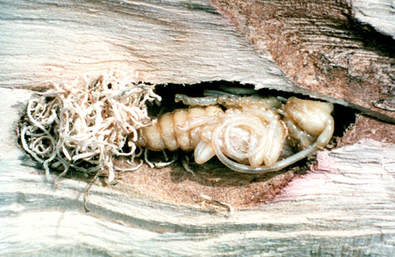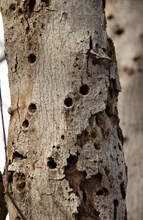ASIAN LONGHORNED BEETLE: DID YOU KNOW?
Anoplophora glabripennis
Anoplophora glabripennis

Native to China and the Korean Peninsula, the invasive Asian Longhorned Beetle (ALB, Anoplophora glabripennis) is in the wood-boring beetle family Cerambycidae. ALB is a pest of maple (Acer sp.) and other hardwoods, eventually killing the trees it attacks. Adult ALB are large, distinctive-looking insects, measuring 1 to 1.5 inches in length with long antennae. Their bodies are black with small white spots, and their antennae are banded in black and white (see picture and video). |
Adult females chew depressions into the bark of various hardwood tree species. They lay an egg (about the size of a rice grain) under the bark at each site. Females can lay up to 90 eggs in their lifetime! The egg hatches within 2 weeks and the white larva bores into the tree, feeding on the living tissue that carries nutrients and the layer responsible for new growth under the bark. After several weeks, the larva tunnels into the woody tree tissue where it continues to feed and develop over the winter. Larvae molt and can go through as many as 13 growth phases. As the larvae feed, they form tunnels or galleries in tree trunks and branches (see picture below).
|
Additional ResourcesUSDA U.S. Forest Service, September 2012
“ Asian Longhorned Beetle and its Host Trees”
Credits: Life Cycle images are used under a Creative Commons license (https://creativecommons.org/licenses/by/3.0/us/):
Egg (cropped): Larry R. Barber, USDA Forest Service, Bugwood.org
Larva (cropped): Steven Katovich, Bugwood.org
Pupa: Kenneth R. Law, USDA APHIS PPQ, Bugwood.org
Additional ResourcesUSDA U.S. Forest Service, September 2012
“ Asian Longhorned Beetle and its Host Trees”
Credits: Life Cycle images are used under a Creative Commons license (https://creativecommons.org/licenses/by/3.0/us/):
Egg (cropped): Larry R. Barber, USDA Forest Service, Bugwood.org
Larva (cropped): Steven Katovich, Bugwood.org
Pupa: Kenneth R. Law, USDA APHIS PPQ, Bugwood.org



